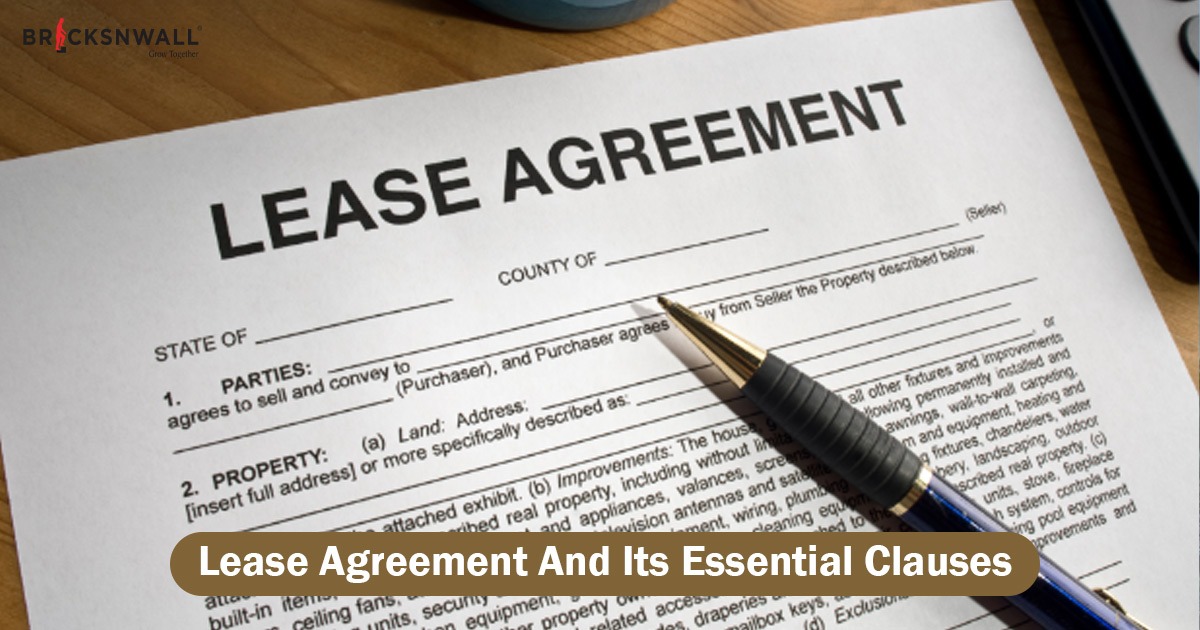Lease Agreement And Its Essential Clauses
Bricksnwall Trusted Experts

In order to define the relationship between landlords and tenants, lease
agreements are essential. By laying up precise terms and conditions, they
guarantee that each party is informed of their obligations and rights.
A well-written lease agreement promotes a positive rental experience by averting future problems and offering legal protection.
A Lease Agreement: What Is It?
A legal contract that specifies the conditions under which a tenant
would occupy a landlord's property is called a lease agreement. The length of
the lease, the rent amount, the due dates, and other relevant terms are all
specified in this document.
In order to avoid misunderstandings and make sure that both parties are aware of their responsibilities, lease agreements are essential.
Essential Elements of a Lease Contract:
Clearly defines the landlord-tenant relationship and defines the legal
connection.
Overviews Property Usage: Indicates if the property is being used for
business or residential reasons.
Protects Both Parties: Serves as a buffer against disagreements or noncompliance.
Lease Agreement Types:
Residential Lease: Used to rent individual rooms, flats, or houses.
Commercial leasing: For retail establishments, office buildings, or
industrial applications.
Short-term Lease: Used for short-term uses, such vacation rentals.
Long-term leases are agreements that run for a number of years and are frequently utilized in business.
What Makes Essential Provisions in a Lease Agreement Crucial?
A lease agreement is an essential document for guaranteeing a seamless renting experience; it is not merely a formality. In the absence of explicit provisions, miscommunications may intensify into conflicts necessitating legal action.
Advantages of Adding Crucial Clauses:
Clarity for Both Parties: Detailed provisions eliminate all possibility
of misunderstanding. For example, defining payment options guarantees that
landlords and tenants are aware of what to expect and how to make payments.
Avoidance of Disputes: Potential disputes are avoided by having clear
terms about maintenance, termination, and deposits.
Legal Validity: A well-drafted lease agreement complies with regional regulations, shielding both parties from potential legal issues.
Important Provisions in a Lease Agreement
Clear expectations and the protection of both landlords' and tenants'
rights depend on a well-written lease agreement. Every leasing agreement should
have the following crucial provisions:
Parties Identification
The complete names and addresses of the landlord and tenant are included in this paragraph. Establishing accountability and making sure that all correspondence about the lease is sent to the appropriate people depend on accurately identifying the parties.
Details of the Property
A thorough description of the rented property, including its full
address and any particular features or boundaries that define the space, should
be included in the contract. This makes it clearer what is covered in the
rental agreement and helps prevent misunderstandings about whose property is
being leased.
Length of Lease
This section lists the lease's beginning and ending dates as well as any conditions pertaining to extensions or renewals. Both parties can better comprehend their obligations and establish a framework for future planning when these dates are stated clearly.
Rent Amount and Terms of Payment
The monthly rent amount, due dates, allowed payment methods (such as
checks or bank transfers), and any late fees are all outlined in this lease.
This provision is essential to avoiding miscommunications regarding financial
obligations and guaranteeing prompt rent collection.
Deposit for Security
This section specifies the required security deposit amount, its usage (for example, to cover damages or unpaid rent), and the terms under which it will be returned at the conclusion of the lease. Both parties' interests are safeguarded against any damages or contract violations by clearly defining these phrases.
Maintenance Obligations
The maintenance responsibilities section makes a distinction between the
tenant's and landlord's obligations with relation to property maintenance. This
could involve regular upkeep, repairs, and liability for harm brought on by renters
or their visitors.
Utilization of the Space
This section lists any limitations on the use of the property, such as
bans on commercial activity, subletting, and unlawful activity. Establishing
precise usage guidelines guarantees adherence to local regulations and
preserves the integrity of the property.
Termination Provision
The terms under which either party may end the lease are outlined in the
termination clause, together with any notice requirements (such as 30 days).
This provision helps prevent disagreements about early termination by outlining
the correct way to discontinue the tenancy.
Clause on Dispute Resolution
This section describes dispute resolution procedures, including
mediation, arbitration, and court proceedings, that may be used during the
tenancy. Both parties' legal expenses can be decreased and conflict management
made more efficient by implementing a dispute resolution procedure.
Clause of Force Majeure
The force majeure provision covers unanticipated circumstances, such as pandemics, natural catastrophes, or government acts, that could affect either party's capacity to carry out their end of the lease. A framework for dealing with such circumstances in a fair and responsible manner is provided by this provision.
Typical Errors to Avoid in Lease Agreement Drafting
A crucial first step in starting a rental relationship is drafting a
lease agreement, but many landlords and tenants make common mistakes that can
cause miscommunications and conflicts. By being aware of these traps, you can
create a more thorough and efficient lease.
Here are some crucial errors to stay away from:
Uncertain Wording
The use of confusing or vague language is one of the biggest mistakes
that may be found in leasing agreements. Tenants and landlords may argue about
unclear wording because they can be interpreted differently.
For example, each party may interpret terms like "proper
notice" or "reasonable wear and tear" differently.
Make sure that every term is clear and precise to prevent this error.
Give precise definitions for key phrases and thorough explanations of rights,
obligations, and responsibilities.
Instead of saying that tenants are required to keep the property
"clean," for instance, define what cleanliness and upkeep standards
are expected. In addition to averting conflicts, clarity helps both parties
understand what is expected of them.
Disregarding local laws
When establishing a lease agreement, another typical error is to
overlook local laws and regulations. Jurisdictions can have very different
rental laws that address things like security deposits, eviction procedures,
and tenant rights. If these laws are broken, a lease may not be enforceable,
and landlords may face legal repercussions.
Before completing your lease agreement, it is crucial to speak with a
legal professional knowledgeable about local real estate regulations in order
to prevent this problem. A knowledgeable lawyer may assist in making sure your
lease safeguards your rights as a landlord or tenant and conforms with all
relevant laws.
Ignoring the clauses on maintenance and repairs
The absence of explicit maintenance and repair provisions is a common
mistake made in leasing agreements. Disputes over damages or necessary
maintenance duties may emerge if it is not made clear who is liable for
repairs, whether it is the landlord or the tenant.
Both sides may become frustrated if expectations are not fulfilled.
Clearly define who is responsible for maintenance and repairs in the
leasing agreement to avoid such disputes.
Indicate who is in charge of minor repairs (such roof leaks or plumbing
problems) and large maintenance (like cleaning and lawn care). Providing these
specifics guarantees that both parties are aware of their responsibilities with
relation to property maintenance and helps to build accountability.
No Conditions of Termination
Another crucial error that might cause issues at the end of a tenancy is
to omit explicit termination provisions. Both landlords and tenants may
encounter challenging circumstances while attempting to end the lease if there
are no clear processes in place.
Misunderstandings regarding notice periods or the circumstances under
which either party may end the lease could arise from this.
Make sure your lease agreement contains clear termination clauses to
avoid this problem. Indicate the conditions under which either party may end
the lease early (such as violation of contract), the permitted means of
communication (such as written notice), and the notice period (such as 30 days)
that must pass before termination.
Smoother transitions when moving out or renewing leases are made
possible by clear exit strategy.
A more effective lease agreement that reduces possible problems and
promotes a favorable renting experience for both landlords and tenants can be
created by avoiding four frequent mistakes: using ambiguous language,
disregarding local laws, failing to include termination terms, and ignoring
maintenance obligations.
Long-term benefits of taking the time to design a thorough lease include
clarity and protection for all parties.
Advice for Writing a Successful Lease
Speak with Experts: Have the agreement drafted by a real estate attorney
or other specialist.
Be Careful When Using Templates: Although online templates can be
useful, they sometimes need to be customized to fit particular requirements.
Customize Terms: Modify provisions in accordance with the needs of the
parties and the purpose of the property.
Keep It Up to Date: Review and amend the agreement on a regular basis to take into account any modifications to the law or the situation.
The bottom line
The foundation of a satisfying renting experience is a well-written
lease. A smooth relationship between the landlord and the renter is ensured by
clearly defining terms, obligations, and expectations. Everyone benefits when
the terms are carefully drafted, reviewed, and agreed upon.
An intelligent real estate partner for AI-powered property appraisals is
Assetscan. It is an easy-to-use software that helps investors with location
trends, real-time property appraisals, and precise micro-market updates.
You can make better, data-driven decisions and make sure you take advantage of the greatest prospects in this booming sector by using Assetscan's AI-powered insights.
- It is the transfer of the enjoyment rights of a property. either indefinitely or for a predetermined amount of time. It could be offered in return for a cash payment or a promise. Such payments can be paid at set times or on a regular basis.
- A lease clause is a particular section of a rental agreement or contract that is signed by the landlord and the renter. These provisions must be in line with existing agreements between the two parties as well as local and state legislation.
- In exchange for regular rental payments, a lessor may offer a lessee the use of a property that the lessor owns or maintains for a specified period of time. This arrangement is known as a lease agreement. The agreement does not give the lessee ownership rights.







